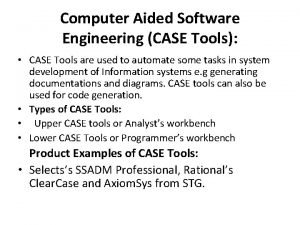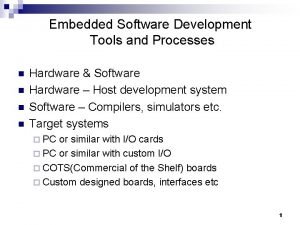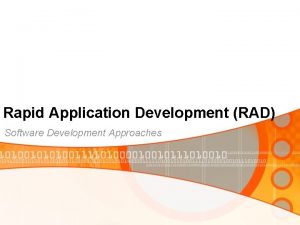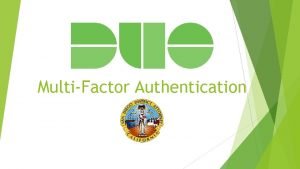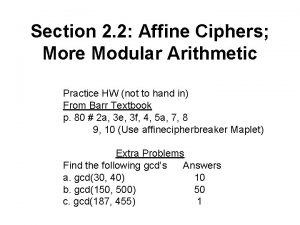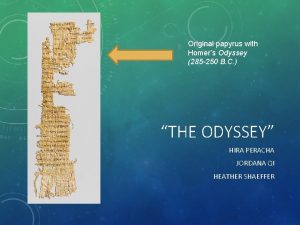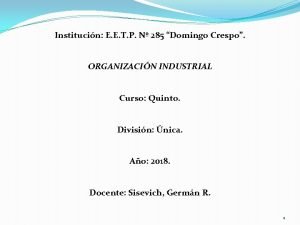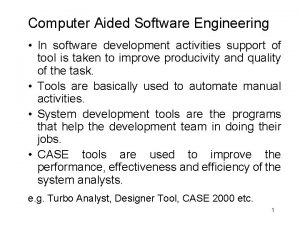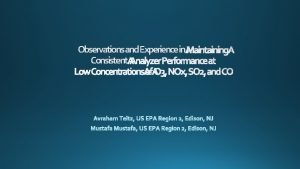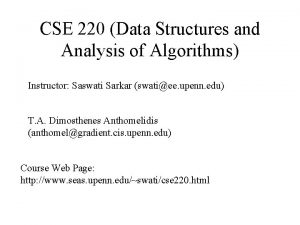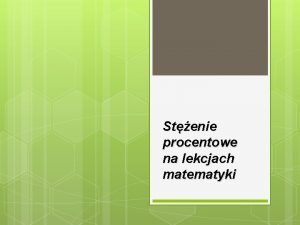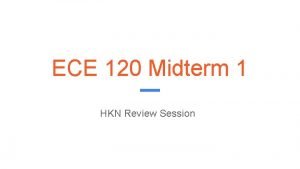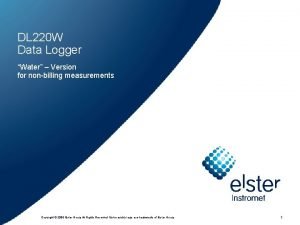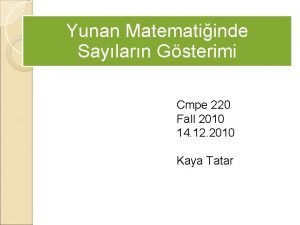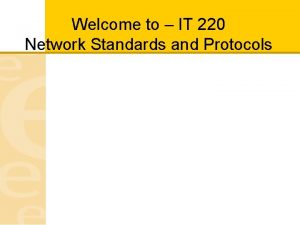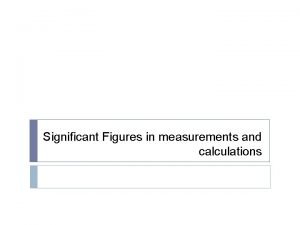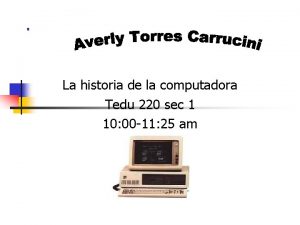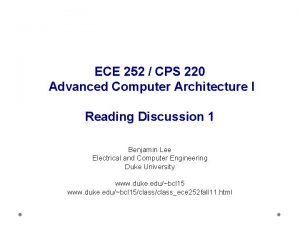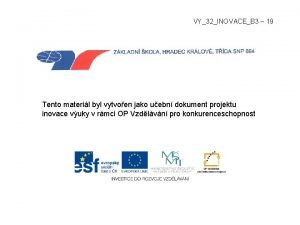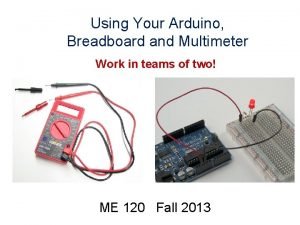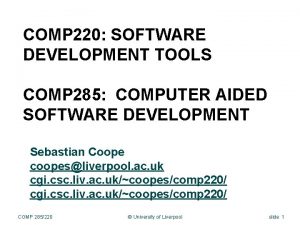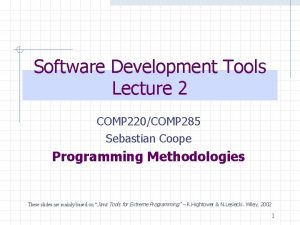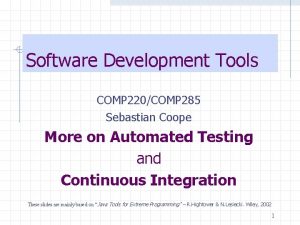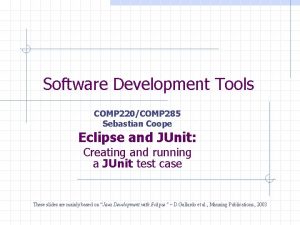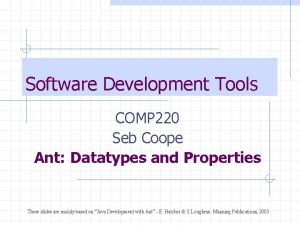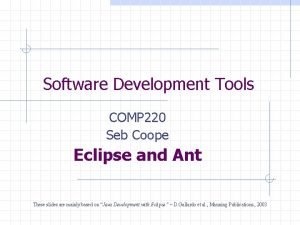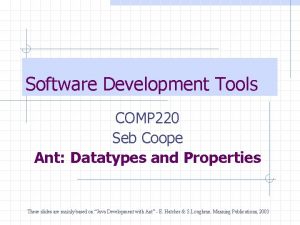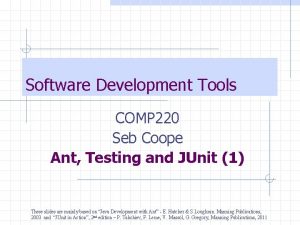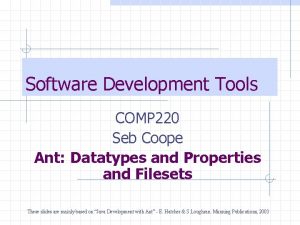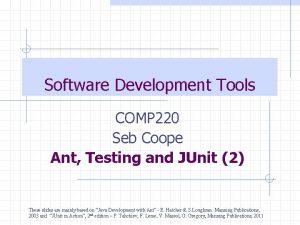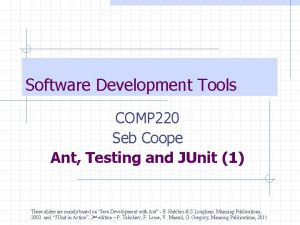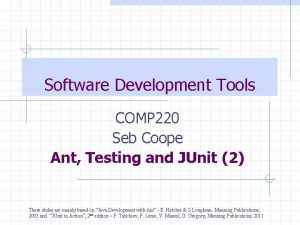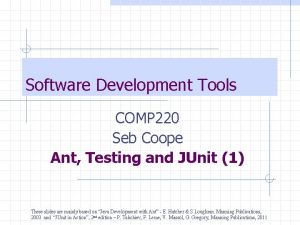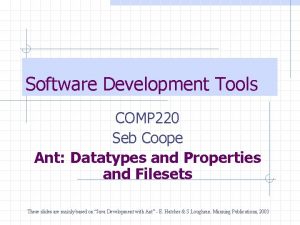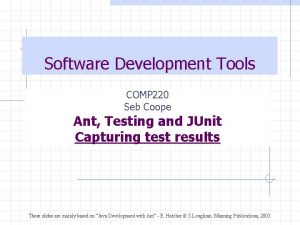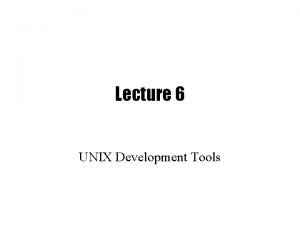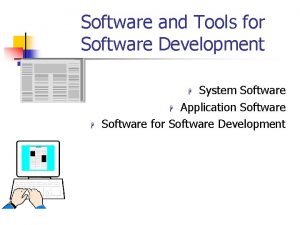COMP 220 SOFTWARE DEVELOPMENT TOOLS COMP 285 COMPUTER




















































- Slides: 52

COMP 220: SOFTWARE DEVELOPMENT TOOLS COMP 285: COMPUTER AIDED SOFTWARE DEVELOPMENT Sebastian Coope coopes@liverpool. ac. uk cgi. csc. liv. ac. uk/~coopes/comp 220/ COMP 285/220 © University of Liverpool slide 1

Delivery • Lectures - 3 Hours/week • Tutorials - 1 Hour week COMP 220/285 © University of Liverpool slide 2

Assessments • COMP 220 - 80% written examination - 20% continuous assessment: - Class Test (1 hour during a lecture) - Lab Test (2 hours: one lab session + 1 additional hour), • COMP 285 - 50% Lab Test (same as for COMP 220) - 50% Practical Assignment (only for COMP 285) COMP 220/285 © University of Liverpool slide 3

Module aims • To explore software development tools and new methodologies of Software Development • To examine the techniques for implementing some Extreme Programming practices such as • Automated Testing, • Continuous Integration and • Test Driven Programming • To provide an insight into Eclipse (Integrated Development Environment) COMP 220/285 © University of Liverpool slide 4

Contents • Methodology of Extreme Programming - (brief, methodological part) • Software testing theory and practice • Introduction to software tools • Source code control • Java Development with Eclipse • Ant (the main tool considered in this course) • Junit (this is the main, technical part of the course) COMP 220/285 © University of Liverpool slide 5

Recommended texts • Java Development with Ant – E. Hatcher & S. Loughran. Manning Publications, 2003 (ISBN: 1930110 -58 -8) – THE MAIN BOOK • Ant in Action, Second Edition of Java Development with Ant Steve Loughran and Erik Hatcher July, 2007 (ISBN: 1 -932394 -80 -X) • Eclipse in Action, A Guide for Java Developers, – D. Gallardo, E. Burnette, & R. Mc. Govern. Manning Publications, 2003 (ISBN: 1 -930110 -96 -0) • JUnit in Action, Second edition(!! For New version of JUnit (4); Old version of JUnit 3 will not be considered. ), P. Tahchiev, F. Leme, V. Massol, G. Gregory, Manning Publications, 2011. (ISBN: 9781935182023) COMP 220/285 © University of Liverpool slide 6

Extra reading • Java Tools for Extreme Programming – R. Hightower & N. Lesiecki. Wiley, 2002 (ISBN: 0 -471 -20708 -X) • Professional Java Tools for Extreme Programming – R. Hightower et al. Wiley, 2004 (ISBN: 0 -7645 -5617 -7) • Test Driven Development – K. Beck. Addison-Wesley, 2003 (ISBN: 0 -32114653 -0) COMP 220/285 © University of Liverpool slide 7

Lab sessions • Labs will be devoted to simple exercises helping to really understand how the software development tools (discussed on lectures) work in practice • Inseparable from the lectures • The best and easiest way to prepare to the Exam and Class Test (for COMP 220) during the semester • Without doing labs well you will be unable to do and pass Lab Test (for both COMP 220 and COMP 285). • COMP 285 will have additional Practical Assignment and no exam. Thus, labs are invaluable for you COMP 220/285 © University of Liverpool slide 8

Websites • www. csc. liv. ac. uk/~coopes/comp 220/ • www. csc. liv. ac. uk/~coopes/comp 285/ • Contain: • General course information and useful links • Course slides • Lab sessions description • Practical assignment for COMP 285 COMP 220/285 © University of Liverpool slide 9

Schedule • Week 1 - Introduction to Software Tools and Agile and test driven development • Week 2 - Introduction to Eclipse and • Week 3 - Testing theory and practise • Week 4 - Eclipse and JUnit COMP 220/285 © University of Liverpool slide 10

Schedule • Week 5, 6, 7 and 8 - Ant and Junit • Week 9 - Issues tracking • Week 10 - Revision COMP 220/285 © University of Liverpool slide 11

Lecture 1 • • Introduction to CASE tools Why bother? What types? How they work in practise? COMP 220/285 © University of Liverpool slide 12

Computer Aided Software Engineering • Well what would be Software Engineering without computers? COMP 220/285 © University of Liverpool slide 13

Output COMP 220/285 © University of Liverpool slide 14

Early days • Software Engineering Stone Age style - All programs verified by hand COMP 220/285 © University of Liverpool slide 15

Early days • Code written in machine code • Not enough memory for debug code addition • CPU time too slow for debugger • No compile stage, so 1 mistake often means program just has fatal crash • Limited output display COMP 220/285 © University of Liverpool slide 16

CASE definition • “The use of tools (usually built from software) which make it easier to build high quality software” S Coope • CASE tools can be - General purpose, example build/test tools (language neutral) - Specialist e. g. Load testing/Do. S tool like Low Orbit Ion Cannon - Built yourself (test harness) COMP 220/285 © University of Liverpool slide 17

Are these tools • High Level Language Compilers/Interpreters • Object Relational Management software - Example Hibernate • Profilers • Debuggers • Code analysers COMP 220/285 © University of Liverpool slide 18

Why tools? • Would you hire a building company who used? - No power tools (productivity cost) - No measuring instruments (accuracy) - No spirit levels or electrical testing tools (quality) - Proper scaffolding/access control (safety) • With software, these issues also matter - Productivity, accuracy, quality, safety COMP 220/285 © University of Liverpool slide 19

Why use CASE? • Used properly - You will become a better software engineer - You will work better with others - Your code will be tested more - You will do things, you wouldn’t normally bother to do (e. g. re-factoring code) - Your life as a software engineering will be slightly less stressful COMP 220/285 © University of Liverpool slide 20

Think of CASE as a series of developments • Machine language (no real CASE) Seb 1983 Apple II COMP 220/285 © University of Liverpool slide 21

Assembly language • Simple case tool called an assembler translates to machine code, 1 to 1 relation to machine code • No type check, complex data types, all abstraction in programmers head COMP 220/285 © University of Liverpool slide 22

High Level Language Compilers • Translate from abstract (non machine language) to machine language of intermediary code • Abstractions are constructed as part of the language, e. g. int, long, String, Person, Bank. Manager • Code is capable of - Being structured - Being tested as part of compilation COMP 220/285 © University of Liverpool slide 23

Interpreters • Programs which run programs, like JVM for Java (Forth, Basic) • Interpreters can be - Source code based (execute the code directly) e. g. Java script interpreters - Fast turnaround time, no-precompile check, only checks running code - Intermediary code based - e. g. Java byte code, slower turnaround, supports pre-compile check COMP 220/285 © University of Liverpool slide 24

Interpreter factors • Program can be debugged by facilities in JVM • JVM can run time check code for - Errors (array out of bounds) - Type conversion issues • Garbage collection (contentious, see i. OS debate) • JVM can be ported to different hardware, making object code portable COMP 220/285 © University of Liverpool slide 25

Intermediary code systems • Allows for multiple languages to easily integrate, parts of code can be written in language of choice • Good or bad thing? COMP 220/285 © University of Liverpool slide 26

CASE in perspective COMP 220/285 © University of Liverpool slide 27

Development IDEs • General purpose - Eclipse (Java, C, C#, C++) etc • Specialist - PHP Storm • Benefits - Improves productivity - Code generation - Integrated debugging - Re-factoring - Integration with other tools COMP 220/285 © University of Liverpool slide 28

Some case tools • Software Debugger - Allows for - Program to be stepped - Variables to be examined - Reading of stack - Inspect event listeners - Focused on specific programming languages - Java. Script in Chrome (can run via remote cable to Android) - Java debugger in Eclipse COMP 220/285 © University of Liverpool slide 29

In circuit emulator • Does all functions of software debugger but at machine instruction level • ICE replaces CPU in target motherboard • Very useful for embedded debugging e. g. smartphone, DVD player etc. ICE CPU socket Motherboard COMP 220/285 © University of Liverpool slide 30

Logic analyser • Does not need to emulate CPU • Can work with any CPU or circuit that probe can connect to • Can read all hardware activity Host machine Read only Data+address info CPU Probe CPU socket Motherboard COMP 220/285 © University of Liverpool slide 31

Logic analyser • Can - Take snapshot of code execution include with trace of code (define usually by break condition) - Run the code at full speed - Not require debug code added - Debug race conditions (speed sensitive) - Monitor hardware/software interaction - Decompile the code to original C/C++ if source code loaded into target - Debug hardware + software • Cannot - Step the code line© University by line COMP 220/285 of Liverpool slide 32

Kernel mode debugging • Same functions as ICE but uses debug features of CPU, driver loaded into OS Debug console Target machine • Examples - Windbug kernel mode for windows COMP 220/285 © University of Liverpool slide 33

Profiler • Calculates how much - Time is used by different parts of your code - Memory is used by different parts of code • Useful for - Code optimization for - Faster code - Code to use smaller memory footprint COMP 220/285 © University of Liverpool slide 34

Logger • Used to record all activities of program • Logged can record activity to - File - Database - Email account • Can be used for - Security logging (e. g. everytime bad password) - Financial logging (everytime a credit card is used) - Debug logging (entry and exit to methods) COMP 220/285 © University of Liverpool slide 35

Logger • In code… - trace ('could not find login', Logger: : DEBUG); • On screen: (http: //test. dunes-software. com: 81/clinic/trace. php) COMP 220/285 © University of Liverpool slide 36

Testing Frameworks • Junit - Allows for testing of code and production of test reports - Integrated for Eclipse in form of Junit Wizard and plug • PHP Unit - Same for PHP • All use assertions to test if code is correct • Using testing framework is important part of Test Driven Development (see next lecture) COMP 220/285 © University of Liverpool slide 37

Stress Testing tools • Mysqlslap - Sends heavy load to My. SQL server • Website load testing tools - Many choices (LOIC simple, Neoload (more complex) - Have to be able to simulate complex real transactions (not just send random traffic) • Benefits - Optimise the performance of website - Determine maximum user load - Determine what happens when system reaches heavy load COMP 220/285 © University of Liverpool slide 38

Code development tools • Code translators - Example Java to Java. Script - Jsweet (http: //www. jsweet. org) - Support for browser DOM objects like - Writing to fields in webpage - Support for HTML canvas - The whole web app active code can be written in Java - Example code is here: - http: //cgi. csc. liv. ac. uk/~coopes/dokuwiki/dok u. php? id=jsweet COMP 220/285 © University of Liverpool slide 39

Benefits of Cross compiling • Have single code base for project - So encryption algorithm server side can be cross compiled to equivalent code for client side • Use higher level language - Java supports type checking (not in Java. Script), private, final, interface definitions - Can use Java libraries (if cross compiled) - Can use Java programmers COMP 220/285 © University of Liverpool slide 40

Project management tools • Zoho - https: //www. zoho. eu/projects/ - Online co-ordinate group project activitiy - (includes scheduling, charts, issue tracking) • Bug management/issue tracking - Active online database for tracking and chasing bugs • Wi. Ki - Easy to edit website (good for general system documentation) COMP 220/285 © University of Liverpool slide 41

Cost Estimation tools • Some tools developed for Cocomo • Agile - Uses poker planning cost estimation - Not many software tools used for this, is mostly a manual process COMP 220/285 © University of Liverpool slide 42

Version document control • Allows - To keep all old versions of files - To allow more than 1 person to change a file at the same time and merge results - To provide access to old versions - To be able to track changes to files • Examples - svn, git • Note - All documents need some kind of version control COMP 220/285 © University of Liverpool slide 43

UML editors • Tools to allow UML diagrams to be produced electronically • Benefits - Higher quality diagrams - Allows hierarchical diagram linking - Things like class diagrams can be used to generate code automatically • Examples - Argo UML, Rational Rose, Papyrus (Eclipse plug-in) COMP 220/285 © University of Liverpool slide 44

Reverse engineering • Takes object code and converts to source code • Used to - Determine how product works - Determine if code is infringing IPR - Hack in, break copy protection • Examples - JD Project (Java decompiler) http: //jd. benow. ca/ - Disassembler (simplistic) - C decompilers • Process needs symbols lists to make sense of code COMP 220/285 © University of Liverpool slide 45

ORM relational manangement • Used to save objects directly to database with programmer having to write My. SQL statements • Benefits - Saves programming time - Reduces My. SQL errors - Improves performance (code can include performance enhances such as sharding) - Allows validation of parameters such as database table names COMP 220/285 © University of Liverpool slide 46

ORM Examples • Hibernate (Java based) • n. Hiberante (C# based) • Example class… public class Stock implements java. io. Serializable { private Integer stock. Id; private String stock. Code; private String stock. Name; private Stock. Detail stock. Detail; //constructor & getter and setter methods } COMP 220/285 © University of Liverpool slide 47

ORM example code <hibernate-mapping> <class name="com. mkyong. stock. Stock" table="stock" catalog="mkyongdb"> <id name="stock. Id" type="java. lang. Integer"> <column name="STOCK_ID" /> <generator class="identity" /> </id> <property name="stock. Code" type="string"> <column name="STOCK_CODE" length="10" not-null="true" unique="true" /> </property> <property name="stock. Name" type="string"> <column name="STOCK_NAME" length="20" not-null="true" unique="true" /> </property> <one-to-one name="stock. Detail" class="com. mkyong. stock. Stock. Detail" cascade="save-update"></one-to-one> </class> </hibernate-mapping> COMP 220/285 © University of Liverpool slide 48

Processes with/without case • No CASE - Tester sends bug report to programmer via email, programmer looks at code, fixes code, sends new source back to tester • Problems - No proper record of bug and fix - Visibility of process limited (team leader manager) - Easy for bugs to get lost - Hard to but priority on bug COMP 220/285 © University of Liverpool slide 49

Bug fix with CASE • Tested finds bug and records on bug management tool (example Bugzilla) and assigns bug to programmer • Bug management tool sends email to programmer • Programmer logs into bug management tool and accepts/rejects bug and adds comment • Programmer updates latest source code from source code control system • Programmer fixes/tests bug using debugger • Programmer re-commits code back to source code control with comment, which links back to bug id • Programmer adds comment from source code control log and comment about how to test bug to bug control system • Team leader downloads all source code and makes new build COMP 220/285 © University of Liverpool slide 50

Bug fixing with CASE support • Looks a lot more work, but most of the CASE processes take v. little time • Allows bugs to be properly assigned to staff • Gives a clear view of the process to the management of the project • One can look back and find out which bugs were fixed on which versions of files • Makes sure that bug reports are filled in correctly COMP 220/285 © University of Liverpool slide 51

Summary • Using CASE can make you - Quicker - Better team working - More controlled • Many tools to choose from • Using IDE will encourage best practise • We will be looking in more detail at some of these tools in the next lecture COMP 220/285 © University of Liverpool slide 52
 Computer aided software engineering tools examples
Computer aided software engineering tools examples Embedded development tools
Embedded development tools Rad in software engineering
Rad in software engineering 55+46
55+46 Lirik pkj 285
Lirik pkj 285 858-285-6020
858-285-6020 Liedboek 285
Liedboek 285 Heer geef vrede
Heer geef vrede Psalm 86 liedboek
Psalm 86 liedboek Decipher the message
Decipher the message Zodiac futura fastroller
Zodiac futura fastroller 285+250
285+250 Produccion por lotes
Produccion por lotes Diocletian divides empire
Diocletian divides empire Computer aided software engineering
Computer aided software engineering Sewing tools measuring tools
Sewing tools measuring tools Dopamine calculation formula
Dopamine calculation formula How to find percentage decrease
How to find percentage decrease Definer 220
Definer 220 Ms&e 220
Ms&e 220 Ece 220 uiuc
Ece 220 uiuc Cse220
Cse220 Cec 220
Cec 220 Georg cantor kümeler kuramı
Georg cantor kümeler kuramı 220-901 questions answers
220-901 questions answers Contoh soal relatif prima
Contoh soal relatif prima Ile soli należy dosypać do 6 kg solanki dwuprocentowej
Ile soli należy dosypać do 6 kg solanki dwuprocentowej Smtp 220
Smtp 220 Jala-jala listrik di rumah mempunyai tegangan 220 volt
Jala-jala listrik di rumah mempunyai tegangan 220 volt Ece 220 wiki
Ece 220 wiki 220 280
220 280 Mhr=220-18
Mhr=220-18 Mhr=220-16
Mhr=220-16 Mhr=220-16
Mhr=220-16 Mhr=220-16
Mhr=220-16 Mhr=220-16
Mhr=220-16 220 280
220 280 Dl 220 2006
Dl 220 2006 Mhr=220-17
Mhr=220-17 Pbb dari 220 dan 1400
Pbb dari 220 dan 1400 Yunan alfabesi
Yunan alfabesi Lied 220
Lied 220 It 220
It 220 What is z a/2 in statistics
What is z a/2 in statistics Sta 220
Sta 220 Sig figs on a thermometer
Sig figs on a thermometer La computadora
La computadora Cps 220
Cps 220 Cec 220
Cec 220 Zásuvka 230v zapojení
Zásuvka 230v zapojení How to use a multimeter on a breadboard
How to use a multimeter on a breadboard Sta 220
Sta 220 Sta 220
Sta 220
